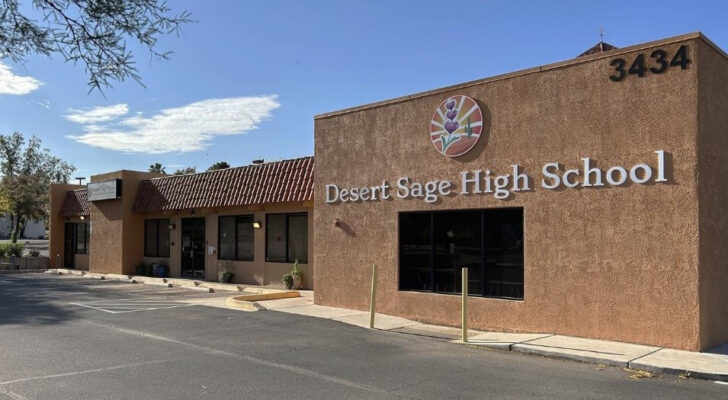Awareness is rising among parents and teachers of the impacts of ubiquitous wireless radiation in classrooms on students’ learning, behavior and health. As such, we Building Biologists need to educate ourselves on the sources of this radiation and mitigation solutions that meet the technology needs of schools. Tech Safe Schools is taking us a long way in this direction. Sharing of practical experiences and of the choices that arise given individual school circumstances will help us reach the ultimate goal of successfully protecting students so they can learn and grow to their full potential.
Desert Sage High School in central Tucson, a tuition-free public charter school, opened its doors to students in August 2022. Before doing so, I performed a Radio Frequency (RF) Radiation assessment and found extremely high levels throughout the school, rising to hotspots of 100,000 microwatts per meter squared (µW/m2) due to ceiling-mounted wi-fi boosters. Upon learning of the high radiation levels, the school had these boosters disabled in short order. I conducted a re-assessment, and remaining levels ranged from 1,030 to 28,000 µW/m2, rising well into the “Extreme Concern” category of the Building Biology Evaluation Guidelines (>1,000 µW/m2).
I determined that a major source of the RF radiation was a T-Mobile cell tower 500 feet to the east of the school. Tucson does not have a protective telecommunications ordinance restricting the placement of cell towers close to homes and schools, and this is the result. Over the next few months, I worked with school administrators to determine the best course of action to shield the East rooms from the radiation. We settled on applying RF blocking paint to the exterior wall facing the tower. The school has a no-cell-phone policy for students, and computers are rarely used for teaching, so radiation bouncing off the painted walls and back onto students and teachers was not seen to be a major problem.
Meanwhile, in February 2023 just as myself and volunteers from a local group, Safe Tech Tucson, arrived to apply a first coat of Eco-Shield paint with a school Principal looking on, I found (in an embarrassing moment) that the high levels of radiation in the building had suddenly disappeared. In one English classroom RF levels had dropped from 6,790 to a safe 125 µW/m2. The project was temporarily called off. I wasn’t able to get any information from T-Mobile itself, so to figure out what had happened I spoke with the slew of workers that began to assemble at the tower daily. They said it had been turned off so it could be “upgraded to 5G”.
During the ensuing three-month grace period, I had more time to think through the shielding options and came to the realization that RF blocking paint had a disadvantage: the fast-growing school would be moving to a different location in two to three years, and the new occupants of the building might not be a low-wireless school, raising an ethical concern. Thus, after some discussion with school administrators of the advantages and disadvantages of interior versus exterior shielding, the decision was made to shield the East exterior with removable aluminum metal mesh screening. Eco-shield paint purchased at a generous discount from Safe Living Technologies (thank you SLT!) would be applied to a tower-facing alcove with a door and jutting features that make metal mesh screening impractical.
Just before school ended last May the tower, now emitting RF radiation in the 5G low- and mid-bands, was turned on. Over the summer, I re-measured and found that RF levels in the rooms facing the tower had more than doubled. They were particularly high for the two rooms closest to the tower, an administrative office and a math classroom, almost quadrupling (see Figure 1, yellow and red bars).

After school started in August, it became even more urgent to commence the shielding. School administrators raised several concerns they wanted addressed before the project could begin. They were worried that their cell phones would not work, and they felt they must have them available at all times in case of an emergency. However, a cell tower search revealed plenty of cell towers in non-Eastward directions. Another issue raised was the ability to use computers for state-mandated standardized testing; I laid out options for this rare situation where wireless connections might be needed.
A school parent fronted the money for the materials to start the shielding with a demonstration for the two highest-RF rooms. In October 2023, myself and Safe Tech Tucson volunteers successfully applied the metal mesh screening on the exterior brick walls. We attached the material roof-to-ground in vertical strips using concrete block screws and 1-inch wide washers, being careful to overlap the strips by 4-6 inches (see photos below). We were able to reduce the RF radiation in the rooms by a whopping 95 percent (Figure 1, green bars). While the final levels are still in the “Extreme Concern” category, they are far lower than they were and may be reduced further with roof shielding and judicious use of the building wireless router, an issue that I’m still working on.

The total cost of the materials for shielding the 250-foot East exterior wall of the school is $1,850. Safe Tech Tucson has launched a GoFundme to complete this worthy endeavor that serves not only to protect Desert Sage students, but as a visible message to the entire Tucson community that cell tower radiation is a hazardous environmental pollutant.
The fundraiser is at this link:
https://www.gofundme.com/shield-desert-sage-school-from-a-cell-tower

